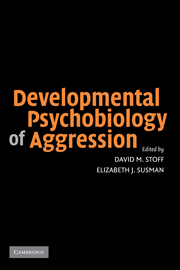Book contents
- Frontmatter
- Contents
- Foreword
- INTRODUCTION
- PART I PLASTICITY
- PART II BIDIRECTIONALITY
- 6 Touch Deprivation and Aggression Against Self Among Adolescents
- 7 Intersections of Biology and Behavior in Young Children's Antisocial Patterns: The Role of Development, Gender and Socialization
- 8 Life-Course Persistent and Adolescence-Limited Antisocial Males: Longitudinal Followup to Adulthood
- 9 A Biocultural Life History Approach to the Developmental Psychobiology of Male Aggression
- PART III GENE–ENVIRONMENT INTERACTIONS
- CONCLUSION
- Author Index
- Subject Index
- References
7 - Intersections of Biology and Behavior in Young Children's Antisocial Patterns: The Role of Development, Gender and Socialization
Published online by Cambridge University Press: 14 July 2009
- Frontmatter
- Contents
- Foreword
- INTRODUCTION
- PART I PLASTICITY
- PART II BIDIRECTIONALITY
- 6 Touch Deprivation and Aggression Against Self Among Adolescents
- 7 Intersections of Biology and Behavior in Young Children's Antisocial Patterns: The Role of Development, Gender and Socialization
- 8 Life-Course Persistent and Adolescence-Limited Antisocial Males: Longitudinal Followup to Adulthood
- 9 A Biocultural Life History Approach to the Developmental Psychobiology of Male Aggression
- PART III GENE–ENVIRONMENT INTERACTIONS
- CONCLUSION
- Author Index
- Subject Index
- References
Summary
A BIOSOCIAL PERSPECTIVE ON AGGRESSION
Problem aggression in young children is viewed as more biologically driven than antisocial patterns that appear in adolescence and thought to be influenced mainly by peer socialization (Moffitt, 1993). Early-onset aggression is more chronic, serious, and linked to long-term maladaptive outcomes. By virtue of disposition or temperament, some young children are more likely than others to behave in ways that reflect disregard for the rights and welfare of others. Several constitutional factors have been implicated in early externalizing problems. These include neuropsychological problems, hyperactivity, and difficult temperament. Different antecedents and outcomes of early versus delayed onset of antisocial behavior have been identified (e.g., Moffitt & Caspi, 2001). Even early-onset aggression has poor parenting correlates, however, suggesting a complex interplay of biological and environmental processes from the start.
In this chapter we focus on early-appearing aggression and the ways in which socialization and child sex interact with it to alter forms of expression and developmental course. We consider, as well, early-appearing prosocial behaviors that may deter aggression. We draw on two high-risk longitudinal studies that have benefited from the teachings of Robert Cairns. He and his colleagues have been at the forefront in guiding the development of theories, research designs, and analytic approaches that illuminate bio-social interactions in different species and at different points in human development (Cairns, 1997, 2000; Cairns, Cairns, Neckerman, Ferguson, & Gariépy, 1989; Magnusson & Cairns, 1996).
- Type
- Chapter
- Information
- Developmental Psychobiology of Aggression , pp. 141 - 160Publisher: Cambridge University PressPrint publication year: 2005
References
- 11
- Cited by

